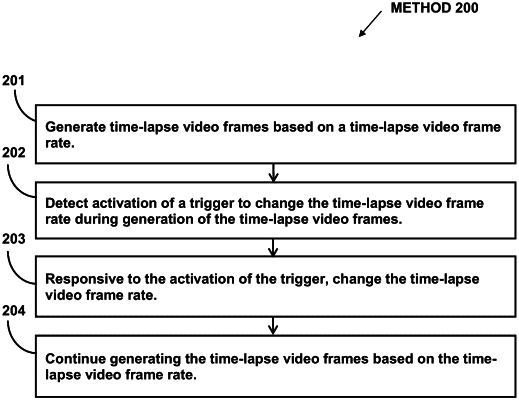| CPC H04N 1/2133 (2013.01) [H04N 23/61 (2023.01); H04N 23/62 (2023.01); H04N 23/631 (2023.01)] | 20 Claims |

|
1. A system for generating time-lapse video frames using a dynamic time-lapse video frame rate, the system comprising:
an image sensor configured to generate a visual output signal conveying visual information based on light that becomes incident thereon, the visual information defining visual content;
an optical element configured to guide light within a field of view to the image sensor;
a touchscreen display configured to present the visual content and configured to receive user input during the presentation of the visual content on the touchscreen display; and
one or more physical processors configured by machine-readable instructions to:
capture the visual content based on a value of a capture frame rate, the value of the capture frame rate different from a first value of the dynamic time-lapse video frame rate, wherein the visual content is stored within a buffer for use in generating the time-lapse video frames;
present the visual content on the touchscreen display;
generate the time-lapse video frames based on the first value of the dynamic time-lapse video frame rate, the dynamic time-lapse video frame rate defining a rate at which the time-lapse video frames are generated from the visual content stored in the buffer, the first value defining a first rate at which the time-lapse video frames are generated from the visual content stored in the buffer;
detect activation of a trigger to change the dynamic time-lapse video frame rate during generation of the time-lapse video frames based on user interaction with the touchscreen display that is presenting the visual content, the user interaction with the touchscreen display including tapping on the touchscreen display;
responsive to the activation of the trigger, change the dynamic time-lapse video frame rate in generating the time-lapse video frames by alternating between the first value and a second value defining a second rate different from the first rate; and
continue generating the time-lapse video frames from the visual content stored in the buffer based on the dynamic time-lapse video frame rate such that the time-lapse video frames include a first set of time-lapse video frames generated based on the first rate and a second set of time-lapse video frames generated based on the second rate.
|